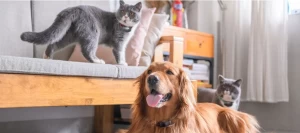
Photo Creds: Invisible Fence Brand
One of the most important things that oftentimes can be overlooked when adopting a pet is ensuring they get adequate amounts of exercise. People often think that just letting their dogs out to use the bathroom or even just having your cats run down stairs is sufficient exercise, but this is not the case. Cats especially gain significant amounts of weight as their owners believe that they do not need exercise like dogs since they sleep more. All types of pets need some sort of exercise. Exercise can help increase the lifespan of your pet, improve their overall health, and increase their qualities of life. Exercise can help release energy in your pets and causes an overall increase in their mental health. Exercise can also help increase the strength of bones, maintain a healthy circulatory and digestive system in your pets, prevent obesity and arthritis, and lower blood pressure (Fitzroy Vet Hospital).
All pets, depending on their age, breed, or size, need exercise of some kind. For example, a senior dog will not need as much exercise that a one-year old will. However, the senior dog will still need to get some exercise. The same thing goes for larger dogs and smaller dogs. Larger breeds, like Golden Retrievers, will need more exercise than a toy poodle. But they both need a healthy amount of exercise too. While how much exercise your pet should be getting depends on factors such as what type of animal they are, size/weight, breed, gender, and age, there are some guidelines that you can start to follow to make sure that your pet is getting enough exercise.
Puppies typically have more energy than older dogs, but since they are little this energy comes out multiple times a day for shorter periods of time. This means being able to take a couple of walks a day with your puppy to make sure they get adequate exercise to ensure growth, promote good behavior, and build good habits. If you are unable to do multiple walks a day everyday, playing tug of rope, fetch, or even running back-and-forth with your puppy can help be good exercise. Doing these multiple times a day, for around 10 minutes at a time, can be extremely beneficial to your dogs mental and physical health. Doing multiple short exercises throughout the day enables your puppy to get good exercise without tiring or hurting themselves.
Once your dog reaches the adult stage, you can do longer exercises with them and do less of them in a day. You can do the same exercises you teach them as puppies and also include some enrichment games, like a frozen dog mat that they must lick down to get the treat. Smaller dogs, such as chihuahuas, need around 1 hour of exercise per day. Larger breeds, like German Shepards, could need up to 3 hours of exercise per day. Other conditions such as respiratory illnesses should be addressed with your vet to see how much exercise your dog needs (PDSA). Lastly, senior dogs need at least 30 minutes of exercise. Their exercises should be determined based on how much they can do. Your senior dog will benefit more from walks rather than running (Small Door Vet).
While cats are known for moving less and sleeping more, they still need exercise just as much as dogs do. Cats are not able to withstand longer increments of exercise as dogs, so multiple small periods are best for them. Like puppies, kittens have a lot of energy that they give off in bursts of energy. This means around 8 10 minute exercise periods per day (Pet MD). Toys, such as a cat tower, wind up toys, balls, and laser pointers are good play options for cats. Adult cats require around 2-3 15-20 minute sessions of exercise (PDSA). While cats do love to sleep, staying fit and active is important to prevent obesity and maintain a good mental health. Lastly, when your cats hit the senior stage, keeping up with daily exercise is just as imperative. Doing around 2-3 5-10 minute exercises everyday with your senior cat will allow them to get necessary exercise everyday. If your cat is refusing to exercise, try exercising with them around dawn or dusk, as this is when they are the most active.
There are also ways to know if your pets are not getting enough exercise. Your pets can display destructive behavior as they aren’t getting their energy out properly, gaining weight, becoming sad or depressed, displaying restlessness, not moving around, and excessive barking (Huntington Beach Pet Hospital). If you notice any of these signs, please talk to your vet to see what a healthy exercise plan could be. Our cats and dogs both need exercise to maintain their physical and mental health. Size, breeds, gender, and more, are factors that go into seeing how much exercise your pet needs. In order to come up with the most successful exercise plan, especially if your pet has pre existing health problems, please reach out to your vet and see what they recommend is best. Every animal needs exercise, be sure to make sure your pet is receiving as much as they need.
